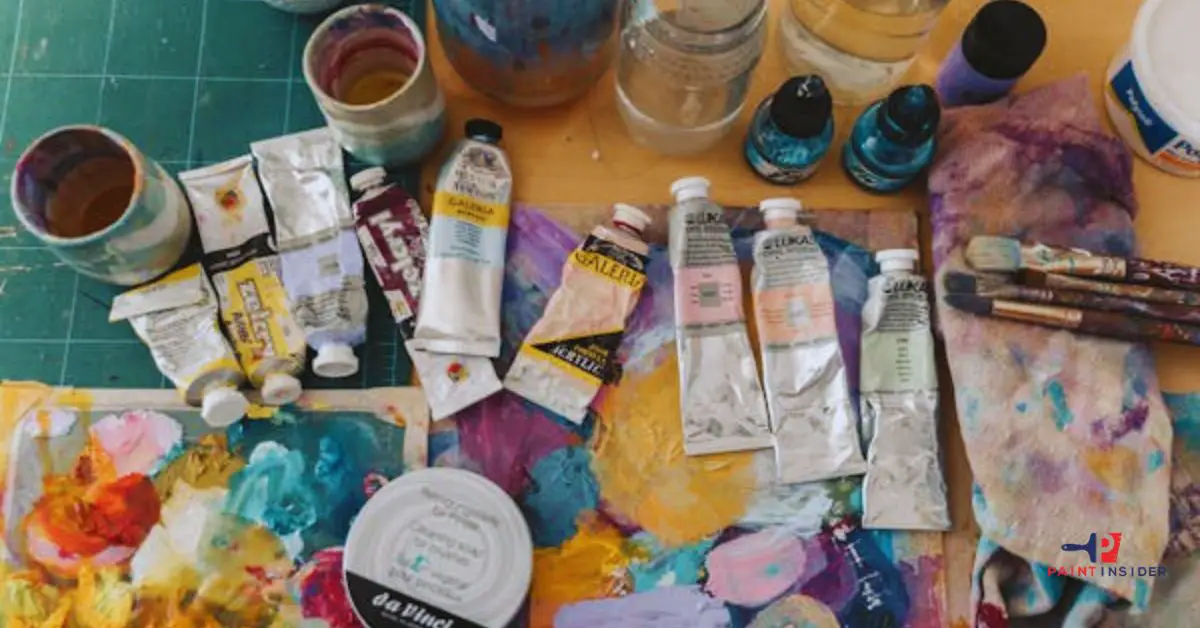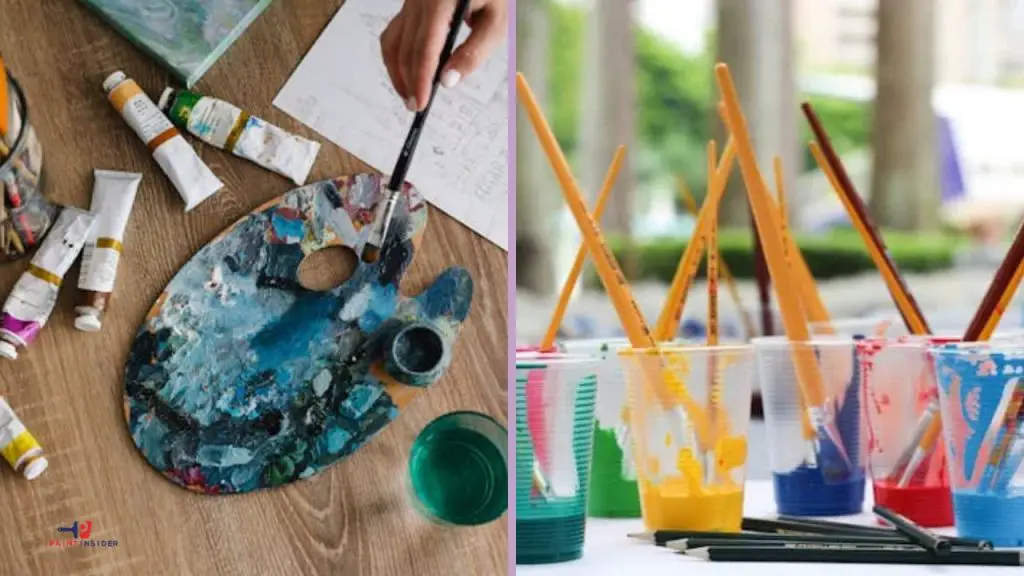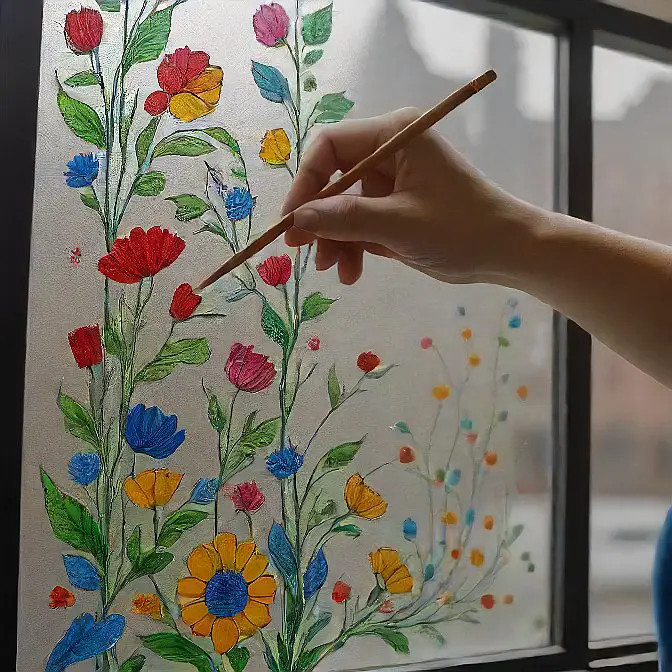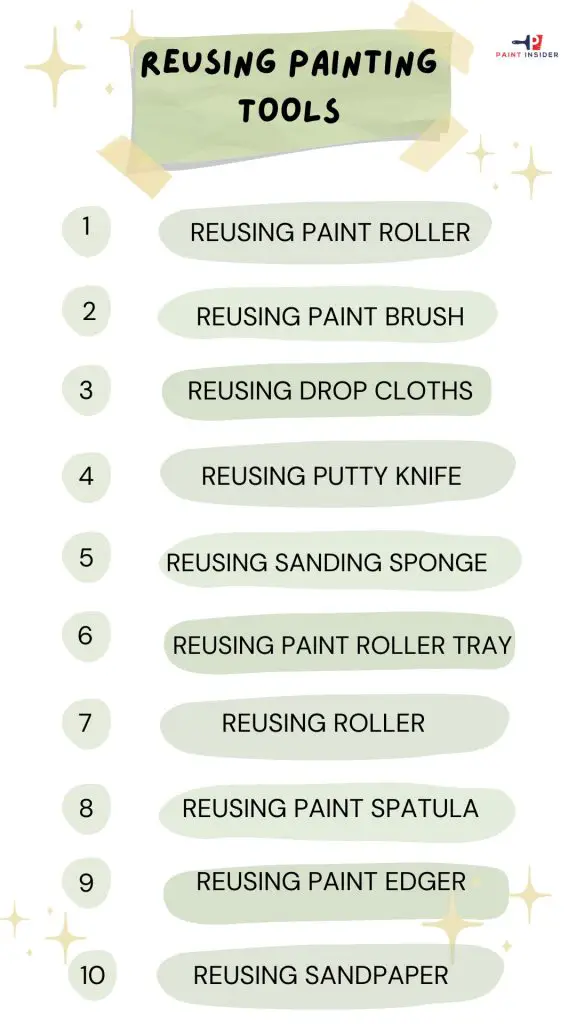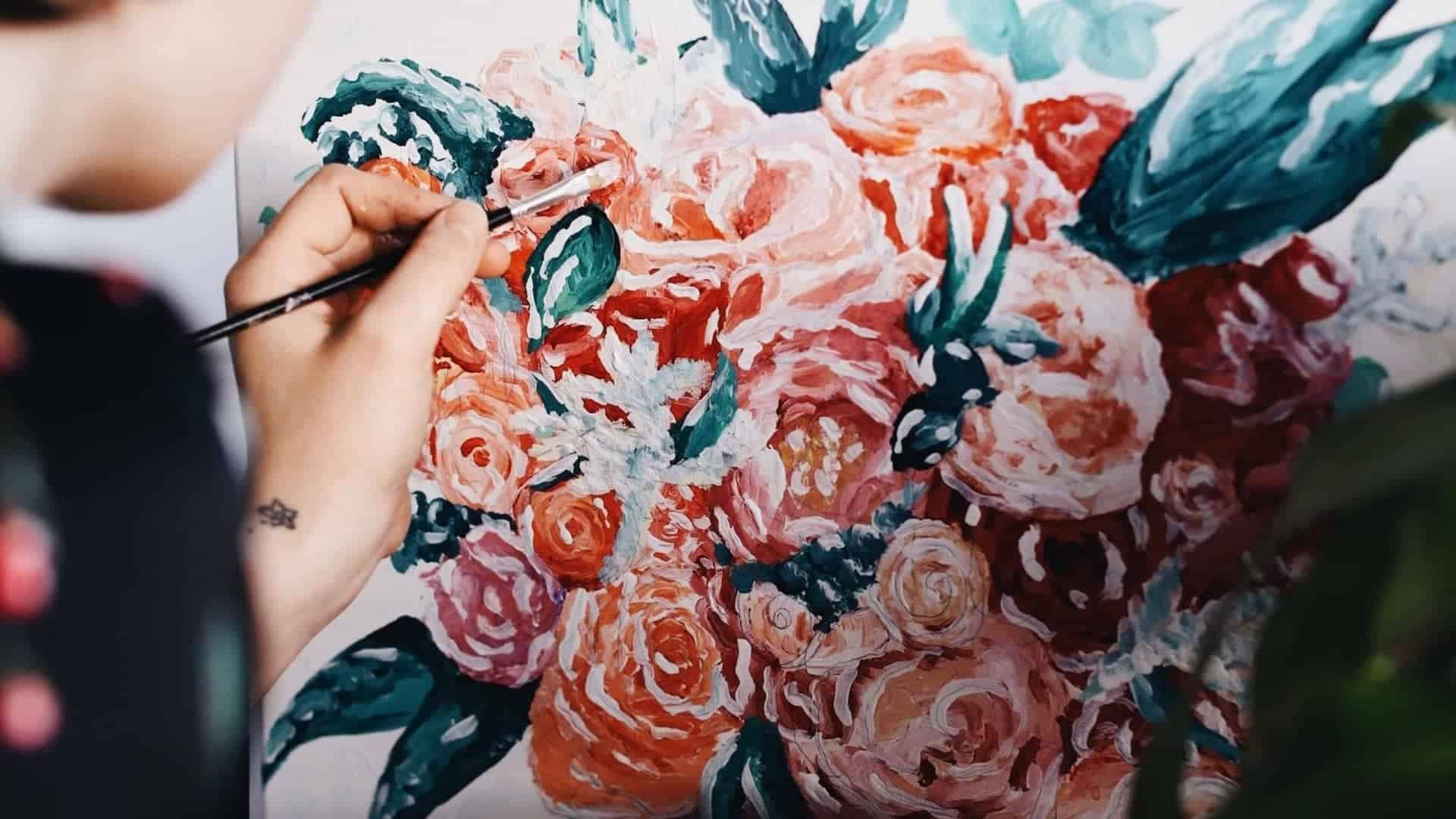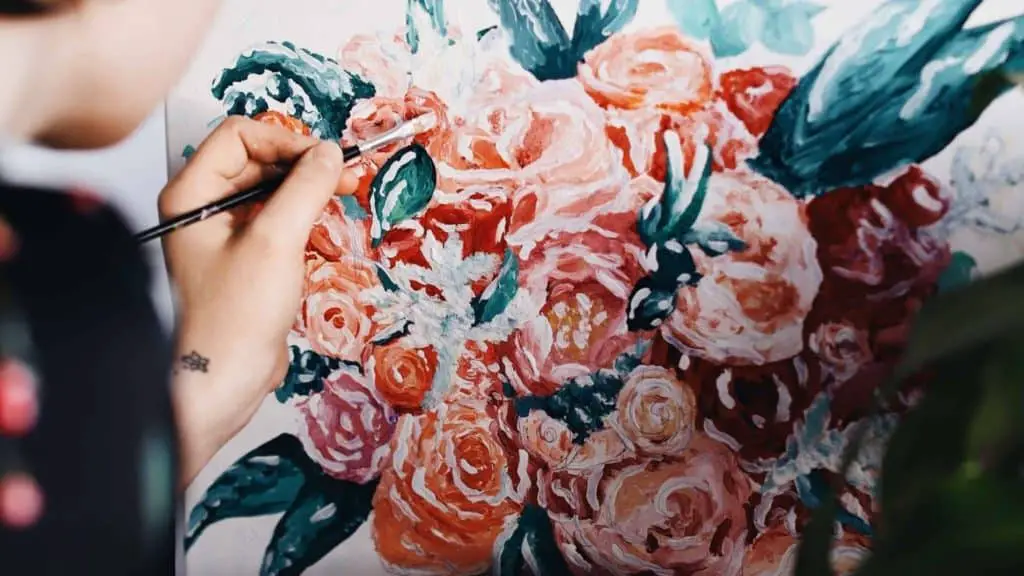Reusing your painting tools can be a money and time-saving idea. Old tools can help you in your projects like the new ones. Besides, it is also an eco-friendly way to paint your walls. It may have seemed hard for you to clean the old tools. However, the best tips for reusing your painting tools effectively will save you a lot.
This entire content will provide you with the best tips for reusing your painting tools effectively. Continue reading the content to get more ideas for reusing your tools.
By cleaning your old and messy painting tools, you can use them several times in future projects. Old tools work great after recycling. Furthermore, recycling the old ones will reduce the amount of trash. Hence, reusing old tools is an effective step with fun.
In this context, I’ll describe some easiest ways to reuse essential painting tools like a paint roller, paintbrush, etc. Besides, you will get a complete idea of storing your tools properly. Let’s get and explore the detailed discussion!
Detailed discussion on reusing painting tools
Reusing Paint Roller:
Paint rollers are essential equipment for decorating walls. For a perfect finishing touch, you have to use paint rollers. Generally, paint rollers contain two parts in the whole structure. One is the roller frame, and the other is the roller cover. Roller nap is the most considerable thing for paint rollers.
If you’re carrying a low budget for your painting project, reusing paint rollers can save the money a lot. Besides, by reusing your paint rollers, you can also save the environment. Paint roller frames are easy to reuse for any project. However, roller covers are quite hard to clean and make suitable for painting again. Now, let’s learn the easiest steps to reusing your paint rollers.
Step-1: Understand The Roller Nap
Roller nap means the thickness of the roller cover. To make the paint roller capable of reusing, you must first understand the roller nap. Besides, if the roller cover is thick, it needs a corrosive cleaning agent. On the other hand, for thin covers, light detergent is enough for cleaning.
Step 2: Detach The Roller Parts
Detach the roller frame and the cover from each other. It makes cleaning much easier. Furthermore, the detached roller cover is quite effortless to soak in the cleaning agent. You can store the roller frames for reusing them in your next painting projects. Roller frames last longer than roller covers.
Step 3: Remove The Leftover Paints
Before cleaning the roller, remove the leftover paint from the roller cover. The leftover paint becomes dry most of the time and complicates the cleaning process. For this reason, use a putty knife to remove the excess paint immediately after painting. Besides, you can keep the roller inside the fridge to prevent dryness.
Step 4: Make A Perfect Cleaning Solution
A perfect cleaning solution is essential to clean and reuse the old paint roller. Warm water and a soapy solution are the main ingredients for cleaning paints. However, you can use mild detergents or liquids to clean the roller cover. Adjust the balance of the water and cleaning agent perfectly.
Step 5: Soak And Clean The Roller
Now, leave the roller cover inside the washing agent. Let the paints leave the cover surface. Generally, it takes only a few minutes to remove the paint. Spin the cover inside the bucket. You can use steel wool to clean the fibrils completely. Again, use clean and fresh water to rinse the roller properly. Always use hand gloves to wash this part.
Step-6: Prepare The Roller For Reusing
After washing the roller cover, ensure you make it dry completely. Wet covers can become damp and contain mold. For this reason, keep the roller part in the sun’s rays to dry up. Besides, a wet roller cover makes the application light. When the roller is completely dry, it will be prepared for reuse.
Reusing Paint Brush:
Paint brushes are the other vital equipment for painting walls and various surfaces. These tools contain bristles and handles. Besides, synthetic and natural compounds are the main ingredients of these bristles. Some brushes include polyester compounds in the bristles. You must choose suitable bushes for the project to get the best result in painting.
The thick paintbrush is perfect for applying color on large surfaces. On the other hand, thin ones can do the details jobs in painting perfectly. To complete the project, you must use both of these brushes sincerely. Furthermore, always try to choose high-quality brushes that contain effective bristles for painting surfaces. Now, let’s read about recycling paintbrushes for reuse.
Step-1: Use Warm Water For Oil-Based Paint
Oil-based paints are hard to clean with regular water and cleaning agents. For this reason, warm water and a soapy solution can wash out the fat of the paint. Besides, warm water can help the bristles to remove the paint.
It prevents the stickiness of the paint quickly and doesn’t take too much time to clean the paint from the bristle surface. If your paint is oil-based, remove the extra paint and soak the brush inside the cleaning solution for a while.
Step 2: Use Vinegar Solution For Latex Paint
Spirit and vinegar solution is the best way to clean the bushes with latex paint. Generally, the mineral spirit has more potential to remove latex paint than vinegar. However, vinegar contains natural compounds and naturally washes the bristles. I prefer vinegar to clean the latex paint brushes.
Step 3: Manage The Bristles
Bristles are the most important part of paintbrushes. After cleaning the brush, spread the bristles to clean up every corner. Besides, through this method, the bristle detaches the extra water from the brush. To dry the brush quickly, remember to manage the bristles properly.
Step-4: Dry Up And Reuse The Brush
To paint with an old brush, it needs to be dry perfectly. Otherwise, you need to paint the walls correctly. Wetness can make the paint non-sticky. For this reason, it is essential to dry the wet paintbrush after cleaning it with water. You can use hot driers to absorb the whole moisture quickly.
Reusing Canvas Drop Cloths:
Canvas drop cloths are highly effective for painting large walls or hall rooms. To paint a room, you must cover the furniture and other things to protect them from paint. Therefore, canvas drop cloth can perfectly cover all areas and make your painting easy.
Generally, canvas drop clothes are two types. You can choose plastic and fabric clothes to cover the protected parts while painting. Fabric drop clothes are biodegradable and environment-friendly, whereas plastics are not. However, it is quite a money and environment saver to reuse the old canvas drop cloth in a new painting project. Let’s learn about some effective ways to reuse canvas drop clothes.
Way 1: Buy Reusable And Washable Clothes
There are many reusable and washable canvas drop clothes available in the market. I prefer choosing washable drop clothes to recycle the piece without any hassle. Besides, these clothes are machine-friendly and reduce much toil to clean the cloth properly. For this reason, washable canvas clothes are highly recommended while purchasing.
Way 2: Clean The Canvas Drop Cloth
You can wash your canvas drop cloth in two ways. One is by hand, and the other is in the washing machine. Furthermore, you must use a liquid solution to soak the cloth for hand cleaning. Remember to remove excess paint over the cloth. Now, soak the cloth and rub it softly. A brush will be more effective in cleaning the dry paints.
Moreover, choose an effective cleaning agent if you want to clean the cloth in a washing machine. Remove leftover paints and put the cloth inside the machine with a handful of washing powder. In a nutshell, run the machine and wait to clean the cloth perfectly. Don’t put other clothes with it.
Way 3: Choose a Plastic Drop Cloth
Plastic drop clothes are more effective than canvas drop clothes. These drop clothes can prevent the paint perfectly to reaching unwanted surfaces. Besides, you can seal the paint to come out through this drop cloth. Plastic drop clothes are quite easy to clean and reuse.
Furthermore, canvas drop cloths can leak paint sometimes. But plastic ones never let the paint reach the surface. Again, these clothes are inexpensive and also effective for small projects. Large-size clothes are suitable for hallroom projects. Hence, choose plastic drop clothes instead of canvas drop clothes.
Way-4: Turn Into Decorative Piece
If you have used your drop cloth several times, it is time to replace it with a new one. However, you can still use this old one for another purpose. The oldest drop clothes can be a perfect decorative piece for your unpainted walls and hall rooms. Even you can decorate your stages for various functions. Furthermore, clean and cloth and decorate the cloth with new paints. Dry up, and it will be ready.
Reusing Putty Knife:
Putty knife scrapes or applies the paints effectively. Besides, this tool is useful for mixing up different paints and making textures over the wall. A Putty knife is made from metal and plastic wood. It contains a sharp blade that helps the tool remove paint or dirt from the surface without any hassle.
Furthermore, as these knives are metallic, releasing them into the environment is unsafe. These putty knives are quite costly sometimes. For these reasons, you should recycle the old putty knives and apply them to your new projects. Proper maintenance can make the oldest tool perfect. Let’s see the steps of recycling a putty knife.
Step-1: Soak In Water
If the putty knife becomes dry, the paints get hard to remove quickly. For this reason, making the paint soften will be the only way. Warm water makes the hard paint removal process much easier. For this reason, take some warm water in a bowl. Soak the tool inside the bowl and leave it overnight. Finally, the paint will leave the surface.
Step 2: Remove Excess Paint
Excess paint can become dry and hard to remove while cleaning. In this situation, you just need to clean the excess paint first. After soaking in warm water, the paint becomes soft and wet. Now, you have to remove the paint from all over the surface. Always use hand gloves before coming in contact with wall paints.
Step 3: Soak In A Cleaning Solution
Make an acidic and corrosive cleaning solution to clean the putty knife completely. You can use lemon juice and vinegar solution to clean your tool with natural ingredients. Furthermore, soak the tool inside the solution for a few hours. It leaves all the paint and dirt on the surface quickly.
Step 4: Wash With Clean Water
Rub the knife and clean it with warm water. A cleaning agent dilutes the paints and helps the surface to cut out the stickiness. Besides, it also makes the surface smooth and clear. You should clean the paint by using mild scrubbers. Finally, wash all the paints with fresh water.
Step 5: Sharpen The Blade
Old putty knives lose their shine and sharpness quickly. However, you can’t get the best result in the painting project in this situation. For this reason, you must sharpen the top of the knife carefully. You can use different corrosive surfaces or sharpener machines to remove the rust. It turns the old knife into a new one.
Step-6: Use It For The Project
When all the following steps are done, your knife will be ready to use in the project. Reusing an old putty knife will greatly save you time and money. However, you can reuse a putty knife only several times. It needs to provide better service after breaking the blades.
Reusing Sanding Sponge:
A sanding sponge is a mandatory painting item to sand various things like drywall, painted walls, plastic, etc. This tool makes removing tasks easy and quick. Besides, the sponge contains an abrasive surface. For this reason, paints and other unfurnished surfaces can become smooth without any hassle.
However, sanding sponges can create a lot of dust while rubbing over the surface. In this case, a wet sanding sponge can handle the situation in the best way. Sanding sponges are quite expensive and hard to manage. That’s why you can make the best use of old ones by recycling them properly. Here, I’ll describe the three best ways to recycle your old sanding sponge.
Way-1: Clean The Sanding Sponge:
Cleaning the sanding sponge is one of the best ways to use your old and used tool effectively. If you want to clean the sponge, prepare a potential cleaning solution. Furthermore, it needs to be if the sanding sponge is too old and dirty. You can use warm water with soap powder or washing powder.
Besides, liquid agents are also effective for cleaning sanding sponges. I suggest using corrosive agents to remove paint and dust completely. Now, soak the sponge inside the solution and leave it overnight. It leaves all the paint and dust quickly. Soon it will become a new sponge for your next project.
Way 2: Cover With A New Sand Paper:
This technique can save both your time and money. By covering it with new sandpaper, you can clean the surfaces without any cleaning. Besides, through this new sandpaper, you will get the same service as the new one. New sandpaper can cover and prevent dust a lot while rubbing the surface.
However, always wear gloves if you want to rub the surface roughly. Most sandpaper needs to cover the sand sponge completely. In this situation, it becomes rough to hold the sponge. You can wet the sandpaper to avoid this type of irritation.
Way 3: Use the Shoe Sole To Sand The Sponge:
If you want to clean your sand sponge using the easiest trick, your old shoe sole may help you a lot. The shoe sole contains a curved surface that can make the sponge surface sharp and tough. For rotating the sponge surface you must need a grinding machine.
After that, it is the time to handle the major challenge. Hold the shoe sole with the sponge surface and rotate the machine. Furthermore, change the only part and direction after rotating for a few minutes. It will make the sponge sharper and more corrosive. When the entire surface is complete, put off the sponge from the sponge, and your tool will be ready.
Reusing Paint Roller Tray:
A paint roller tray helps to carry and apply paint over the roller. For using a paint roller, a paint roller tray will be the must-have item to complete the project. Furthermore, the paint roller tray is a plastic tray with a large space. It contains a deep slope to mix the paint with the paint roller.
This handy tool can become dry and dirty quickly. That’s why users are interested in something other than recycling paint roller trays. For this reason, the cleaning process is quite lengthy. However, applying some effective ways can make this process easy. Now, let’s check the best ways to recycle the tray easily.
Generally, paint liners are suitable for covering the furniture during the painting period. However, you can also use these tape liners for various purposes. Covering the paint tray with liner tape can save the surface from unwanted paint. Besides, this method reduces the cleaning hassle a lot.
The paint tray must be dry and moisture-safe for using liner tapes. It is because the wet surface can’t stick with the plastic properly. After applying the tape, you must provide enough pressure to adjust the tape and plastic. Lastly, you can use heat for seating the liner for a long time.
A paint thinner can remove any paint without any hassle. It contains some acidic and chemical formulas to remove the paint quickly. Furthermore, paint thinner can lose the paint quickly rather than any other option. If you have a time shortage, you can use this element to remove paint from the tray.
Firstly, remove the excess paint through a paint scraper. If the paint becomes dry, use some warm water and lemon juice. After that, pour the paint thinner over the surface and paint the affected areas. Wait for a few minutes, and your paint tray will finally be as new as before.
A tool can remove the paint from the tray without any manual touch. The power washing tool is perfect for washing your paint tray without hassle. Furthermore, this gadget can help the user to reduce time and money consumption for the project.
Regular cleaning agents can be ideal for washing your plastic paint roller tray. Washing powder and liquid cleaning agents are considered reliable ways to remove the color. However, the paint tray needs more time to wash properly through these elements.
Reusing Roller Extension Pole:
A roller extension pole is a multi-purpose tool for every homeowner. Through this tool, you can clean your whole house without any hassle. Besides, this roller extension pole can also do decorative tasks as it contains a good length. You can paint your ceiling easily by using an extension roller pole in the paint roller.
Extension rollers are metal-based tools to serve in various household works. That’s why this pole is almost an essential tool for every homeowner. However, to reduce your cost, truly take care of your extension pole! Let’s know the methods carefully!
Detach And Store All The Parts:
Generally, extension poles are medium size detachable poles. These tools are made from steel or other metallic ingredients. And that’s the reason you must keep the detached parts safe. You have to keep the separate parts in an airtight area to prevent various damages. Large-size poly bags can be a good option to store your extension poles.
Firstly, detach all the parts carefully. A lengthy extension pole is hard to store in any place. Hence, detach the medium size parts one by one. Never store a part that contains any moisture inside or outside. Besides, it would be best if you cleaned all the paints on both sides of the poles before storing them.
Protect From Rusting:
Rusting is the main danger in extension poles, as these tools are made from metallic elements. Yet by implementing the most potential methods, you can save your extension poles from rusting. Proper cleaning and drying is the leading solution for preventing rust. Dry paints can damage the metallic surface a lot.
Furthermore, moisture creates harmful elements that can damage the pole inside and outside. For this reason, clean all the paints with thinner or washing agents. Remember to dry your extension pole. Sun rays are the best way to dry up the poles perfectly. Dry the tools and store them inside the wooden drawers for a better result.
Use Oil To Clean Rust:
Oil can be another best option to clean rust. If your extension pole is unfortunately affected by rust, use oil over the surface as a solution. Furthermore, oil can smooth the tool and give it a new, shiny look. By using turpentine oil, you can finish this task easily.
However, keep your extension poles in contact with moisture. It makes the rust more stubborn and hard to clean. Now, rub the surface swiftly and clean it with fresh water. Besides, you can use any acidic cleaning agents in this case. Your old extension will be ready to support you in the project.
Reusing Paint Spatula:
A paint spatula helps to apply paints and make different textures over the walls. Stainless steel, metal, and wood are the main elements of these tools. The spatula contains steel, and the handle includes hardwood. To complete any painting project, you have to keep a paint spatula. Old spatulas can also be more effective for your job.
However, old spatulas contain rust and other dirt that damage the surface deeply. Through some secret tricks, you can recycle and fix these issues without hassle. Now, I’ll tell you some ways to recycle and properly use your old paint spatula.
Lock In An Air Tight Area:
Paint spatula can become damaged through so much rust. Besides, old spatulas lose their shine and gloss. These tools can ruin the paint while applied over the wall surface. For this reason, if you want to reuse your spatula, clean the entire paint immediately after using it and dry it up properly. Use poly bags or airtight areas to lock your spatula from rusting.
Cover With Oil:
You can apply oils while storing the metal spatula to prevent various damages. You can find out various metal storing oils for preventing rust in the market. Furthermore, soak the spatula in the oil and keep it overnight. It sucks the necessary amount and will be ready to store. You can store the spatula inside a poly bag or airtight box.
Replace The Spatula Handle:
The spatula handle is made from hard or soft wood. For this reason, the wood sucks moisture from the environment a lot. This moisture later creates rust over the metallic spatula. If you find the spatula old and wet, change it immediately to protect your paint spatula from rusting and other damage.
Reusing Paint Edger:
The paint edger completes the project by finishing the edge lines and corners of the rooms and walls. Besides, this tool can fill any holes and scratches quickly. For this reason, a paint edger is considered the finishing tool for any painting project. However, an old paint edger can save your investment a lot. Check out the steps below to recycle your old paint edger perfectly.
Step 1: Wipe The Paints
The paint edger contains a lot of extra paint over the roller. These paints should be removed quickly after painting. Otherwise, it can become dry and hard. You must use a heavy towel or steel wool to remove the paint from the roller surface. Furthermore, warm water and a soapy solution can make this task easier for you.
Step 2: Prepare Cleaning Agent
Now, prepare a suitable cleaning agent for your paint edger. An acidic cleaning agent or regular corrosive liquid can clean the paint perfectly. Furthermore, always use mild warm water to make any cleaning solution to remove paint. Lemon juice and vinegar solution can be another good option to remove paint.
Step 3: Soak And Rub The Tool
Soak the edger roller in the cleaning agent completely and keep soaking about one hour at least. When the roller starts to leave the paints, rub it with steel wool or brush to clean the edger. I prefer a brush as the bristle can reach the paints more than steel wool. Remember to detach the roller cover.
Step 4: Clean The Cover
You have to clean the cover separately after cleaning the other parts of the edger. The roller cover is quite sensitive and soft. Furthermore, you must use mild detergent or cleaning products to clean the cover properly. Soak and let the paint leave the cover. Now, wash it by using your hands gently.
Step-5: Wash With Warm Water
You must clean the paint edger with warm water as the last washing step. Warm water can dilute the paint quickly. Besides, it makes the tool shiny and smooth after cleaning. Pour warm water over the painted surfaces and rub with a soft sponge or scrubber. It removes all the leftover paint spots and provides a complete cleaning touch.
Reusing Sandpaper:
For furnishing any surface, sandpaper is an essential tool. Sandpaper can sand and burnish any wood, plastic, drywall, and painted wall perfectly. However, these sandpapers are expensive and hard to get according to the grit number and corrosiveness. You can clean and reuse your old sandpaper by following the below.
Soak It Overnight:
It would be best if you made a suitable cleaning agent to clean your dusted sandpaper properly. The liquid solution is highly suggested. Furthermore, warm water and a cleaning solution will quickly remove dust or paint. Soak the entire sandpaper in the agent and leave it overnight.
Rub With Steel Brush:
A steel brush is the best way to remove hard particles from the sandpaper. Hard particles are quite difficult to remove over a corrosive surface. Besides, the corrosive surface holds these particles tightly. However, using a steel brush removes and cleans the wood or paint particles deeply. Rub the corrosive portion and clean it properly.
Clean With Water And Dry:
After rubbing with a steel brush, your sandpaper will almost be ready. You have to clean the paper with warm water as the last cleaning step. Soak the sandpaper and rinse it thoroughly. Furthermore, leave the sandpaper under the sun’s rays and make it dry completely. Your sandpaper will become a new one for your next project.
How To Store The Painting Tools?
Painting tools are expensive but reusable. If you want to reuse your painting tools in future projects, you must learn the correct ways to store the painting tools for a long time. A proper storage system can prevent any damage. Besides, it saves a lot of time on a new project. Now, let’s know the correct ways to store painting tools effectively.
Air is the main culprit of rust over metallic painting tools. Iron rust is quite hard to clean. On the other hand, this rust can destroy the metal surface completely. It would be best to store your small to medium size painting tools in a poly bag. However, use a large poly bag or plastic container to seal the tool for a long time for larger tools.
Never leave the painting tool for a long time after painting. It makes the paint dry and hard to remove. Besides, dry paint stuck over the surface tightly and faded the smooth tools. For this reason, you have to clean the tools immediately after painting any wall or room.
Scrap the excess paint before storing the painting tool. Extra paint makes the cleaning process lengthy and hard. Furthermore, these paints create a heavy layer over the surface quickly. In this case, use a paint scrapper to scrap the excess paint properly and clean the tool perfectly.
Moisture can damage the metallic surface easily. Besides, after rinsing with water, the water drops make spots over the tools that reduce their shine. For this reason, you must make the tool fully dry before storing it for a long time. Keep the tool under the sun’s rays and let it dry.
Air and water are the main ingredients that create rust over the painting equipment. If you want to avoid rust, you have to avoid these elements perfectly. For this reason, never store a wet metallic tool inside a common storage room. Make the tool dry first and store it inside air-free storage at the proper temperature.
- Keep The Tools Separately:
Always store the tools separately if you have a lot of painting tools together. Otherwise, it can exchange colors and stick with the surfaces. Besides, if the tool comes in contact with a rusted tool, it also becomes affected. Use different poly bags to store the different painting tools.
- Detach The Roller Covers:
Before storing the paint rollers, detach the roller covers from the frame. Sometimes, the frame creates rust and spreads inside the cover if you don’t detach the roller cover. Store the cover inside another poly bag without the frame. Be sure the bag is airtight and clean to store the roller cover perfectly.
The extra lengthy tool can’t fit inside a poly bag or container. The extension pole, paint roller frame, and paint edger frame contain a high length. For this reason, you must use foil paper to cover these tools perfectly. A foil paper can prevent air and other moisture from protecting the metallic surfaces.
- Keep Inside The Wood Drawers:
Wood drawers can be another best option to store your painting tools. These wood drawers can prevent moisture from keeping the tools reusable. Besides, wood drawers last long and defend against various bacteria and insects. Keep all your large to medium-sized tools inside the wood drawer.
- Provide Heat To Suck The Moisture:
Provide enough heat to your stored tools often. Proper heat helps the tools suck the moisture completely. By following this process, it will become possible for you to keep the tool anywhere long. Besides, enough heat can help the environment to manage the temperature perfectly.
Frequently Asked Questions (FAQs):
How Do You Clean Tools After Painting?
Prepare a soapy cleaning solution with soap and mildly warm water. Afterward, take this solution inside a bucket and place a heavy bristle brush in the middle. Now, put your dirty tools in and rotate the bucket to clean them perfectly. Repeat the process until the tools remove all the paint. Finally, rinse them with fresh water and make them dry.
Is It OK to Reuse Paint Rollers?
It is completely okay to reuse your paint rollers in your next project. Proper storing and caring make the paint rollers long-lasting and durable. Besides, cleaning the roller cover allows you to use the paint roller several times. You have to store the roller frame and the cover accurately. Store both of them separately to get the best result.
What Do You Do With Paint Tools Between Coats?
Wrap your paint tools with an airtight wrapper between other coats while painting. It keeps the paint tool fresh and moist. Besides, washing your paint tools between coats can’t handle the paint in the next coat. For this reason, try to hold the moisture in this period. If you need a break between coats, you can coat another wall or room.
Do Professional Painters Reuse Brushes?
Many professional painters reuse their paintbrushes during new projects. If the paint brush contains high-quality and manageable bristles, it can be used many times. Furthermore, even some high-quality paintbrushes can last for years. Hence, reusing a paintbrush completely upsets the quality of the tool.
Should You Wet A Paint Roller Before Using It?
It would be best if you didn’t wet a paint roller before using it on the wall. When a paint roller becomes wet, it holds so much moisture. For this reason, it can’t stick with the paint and suck the liquid properly. Besides, applying paint on the wall with a damp paint roller becomes quite hard. Therefore, only wet a paint roller after using it.
How Long Can A Paint Roller Sit Between Coats?
Between coats, you can sit on a paint roller for at least two hours. After two hours, it starts to lose moisture and soon becomes dry. However, you can use airtight poly bags to prevent your paint rollers from coming into contact with air. Apply this method to finish your project quickly.
The Bottom Lines:
Nowadays, painting tools are expensive and hard to get the actual quality. For this reason, reusing your old painting tools can be the best choice to save you time and money. Old painting tools also work great in new projects.
However, cleaning and reusing your old painting tools is quite challenging. All my tips for reusing your painting tools effectively will help you a lot in your next painting plans. Remember to share your painting experiences using old tools with me via the comment section!
conclusion:
In conclusion, reusing your painting tools effectively not only makes financial sense but also contributes to sustainable practices in art and home improvement. By taking the time to clean and store brushes, rollers, and trays properly, you can ensure that they remain in good condition for future projects. A little effort goes a long way investing in a few quality cleaning supplies can extend the life of your tools significantly.
Moreover, consider repurposing old brushes or rollers for different styles and techniques in your next masterpiece, they can create unique textures that fresh tools may not achieve. Ultimately, being mindful about how we treat our painting materials enriches our craft while fostering a greener approach to our hobbies.




